Solid draws in Carlsen-Duda and Fedoseev-Karjakin
Sunday, August 1st 2021 – After a well-deserved free day, the eight remaining players returned to the venue this afternoon to continue the fight for the 2021 World Chess Cup. They were joined on the stage by Polina Lion, Chief Sustainability Officer of ROSATOM, the largest producer of electricity in Russia, who played the first move in the women’s final.
On board one in the open group, Norwegian World Champion GM Magnus Carlsen (2847), opened with 1.d4, and his opponent, Polish GM Jan-Krzysztof Duda (2738) opted for the Queen’s Gambit declined, starting with the 1…Nf6 move order.
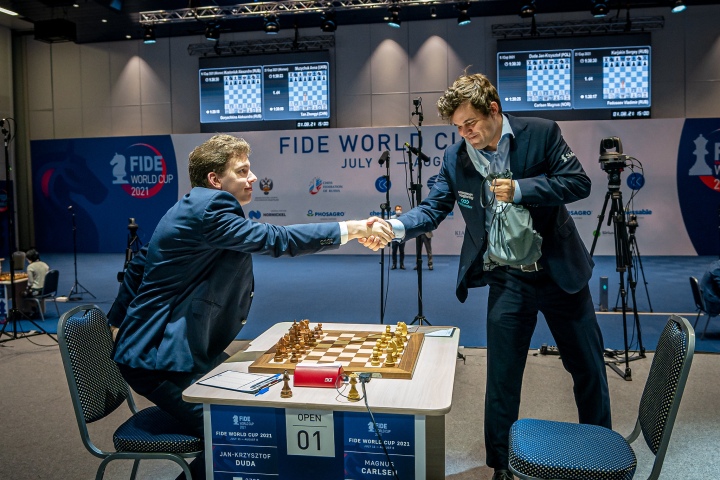
In other games here, Carlsen has preferred the Catalan opening but today he went for 4.Nc3 allowing 4…dxc4, transposing directly into a fashionable variation of the Queen’s Gambit Accepted, in which White sacrifices a pawn for development.
Nothing new under the sun, of course: both players had already tested this line in the 2019 Tata Steel tournament. In that game, Carlsen emerged victorious. However, today he brought a new, and rather less-known, idea to the table.
Duda decided to play it safe by giving the pawn back in order to reach an equal position albeit with an imbalance in the pawn structure and minor piece (knight against bishop). Although Carlsen tried his best to push for a win in the rook ending, Duda played with great precision and a draw was agreed just after move thirty.
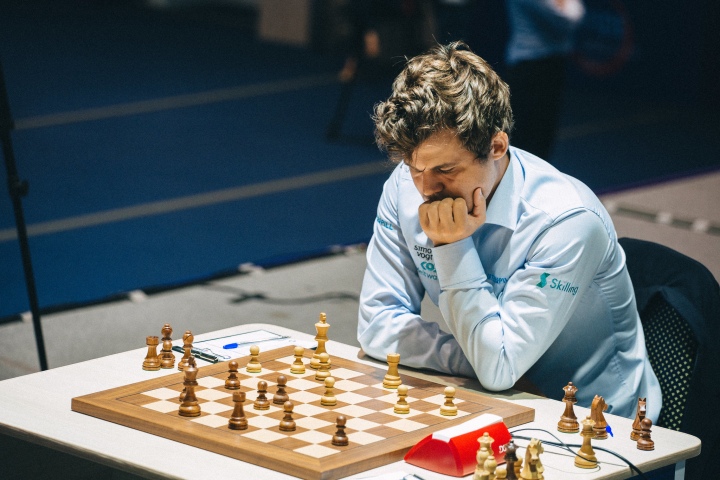
Before he left the venue to prepare for tomorrow’s game, Jan-Krzysztof gave us his thoughts in a brief interview.
A fun fact occurred in the other all-Russian semi-final between GM Vladimir Fedoseev (2696) and GM Sergey Karjakin (2757). The former 2015 World Cup winner chose a very solid side-line in the Queen’s Gambit Semi-Tarrasch variation.
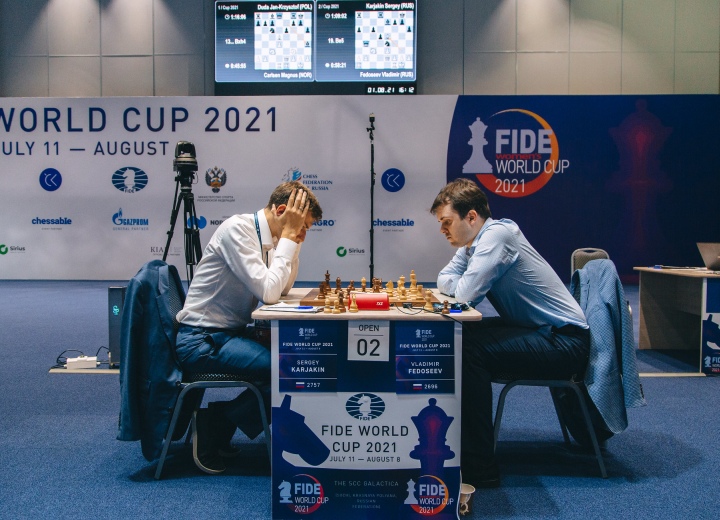
Funnily enough, the same opening was being played a few metres away in the Women’s third-fourth place match! As luck would have it, both games deviated on move thirteen. The position remained equal for most of the game: neither player wanted to risk being essentially eliminated in the first game due to an unforced blunder.
Soon enough, all the minor pieces were exchanged and some lengthy manoeuvring with the queen and rooks began. After more exchanges, Karjakin voluntarily went into a rook ending a pawn down, but in any case, a clear draw due to his passer. As top Russian GM Peter Svidler put it “Karjakin doesn’t lose many of these”.
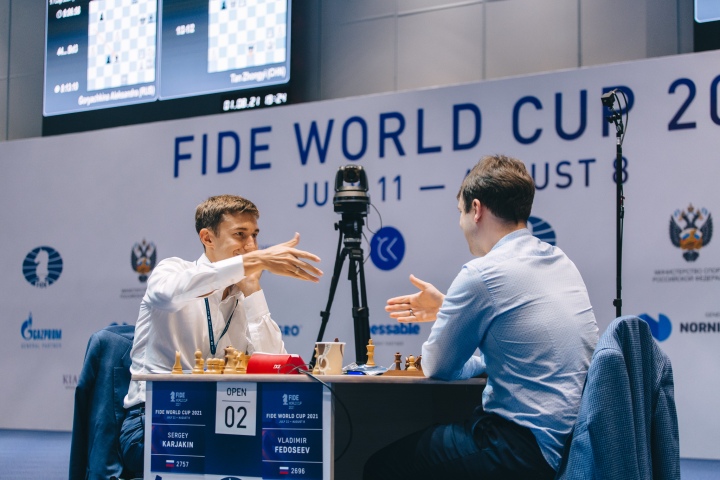
A draw was agreed on move sixty-nine. In his post-game interview, Fedoseev considered that he was pressing most of the game and that some of these rook endings can be won.
In the all-Russian women’s final, between GM Aleksandra Goryachkina (2596) and GM Alexandra Kosteniuk (2472), the rules stipulated that Goryachkina would play with White in the first game. She opened with 1.d4 and soon the game followed the theory of the Catalan opening, one of her favourite set-ups.

On move seven, 7.Be3 was definitely a surprise for Kosteniuk – 7.Bg5 and above all 7.e3 are by far the main moves – and she thought for nearly ten minutes before replying with the sensible 7…Nd5. She was able to keep the balance, in which her two bishops and optimal pawn structure compensated White’s extra space in the centre.
However, fate struck hard on move twenty as 20…e5? was a big mistake. Obviously, 21.dxe5 would just return the blunder due to 21…Rd3 winning, but 21.b4! (after only two minutes of thinking time) was the perfect response.

Goryachkina won a pawn and was clearly in the driving seat. She gradually increased her advantage and could have sealed the deal on move thirty-six if she had played 36.Rd1 intending Rd6 or Rd7, and Black is in big trouble. However, low on time, Goryachkina missed the win.
With both players approaching move forty, huge complications commenced and this time Kosteniuk came out on top.
Goryachkina – Kosteniuk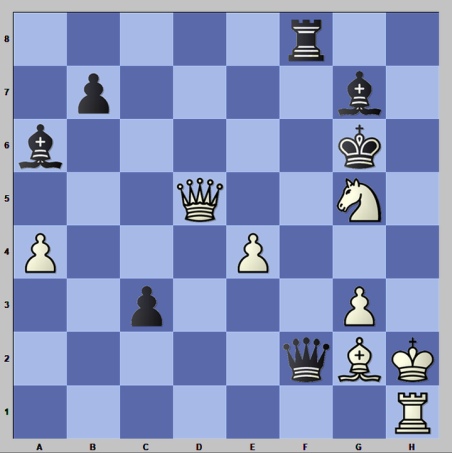
Unfortunately for Kosteniuk, she threw away most of her advantage with 41…Qd4? (instead of either 41…c2 or 41…Qe3 which are both winning), but was lucky enough to get a second chance a few moves later when Goryachkina misplayed the ending, and this time she scored the win.
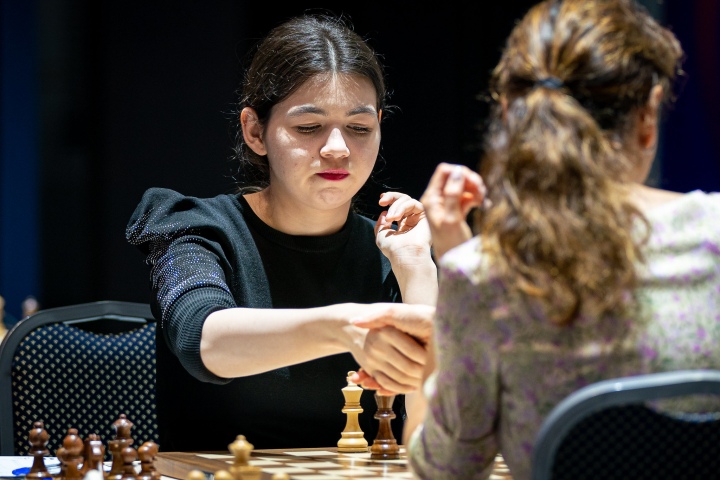
In the match for third place between China’s GM Tan Zhongyi (2511) and GM Anna Muzychuk (2527), representing Ukraine, the Semi-Tarrasch variation of the Queen’s Gambit declined was played, just as in the men’s second semi-final.
However, White’s 13.Bxf6 followed by 14.Nxd5 just didn’t have enough punch to achieve a serious advantage. After a few exchanges, Muzychuk spotted from afar the neat trick with 25…Nd4! and held the queen ending to a draw with no trouble at all.
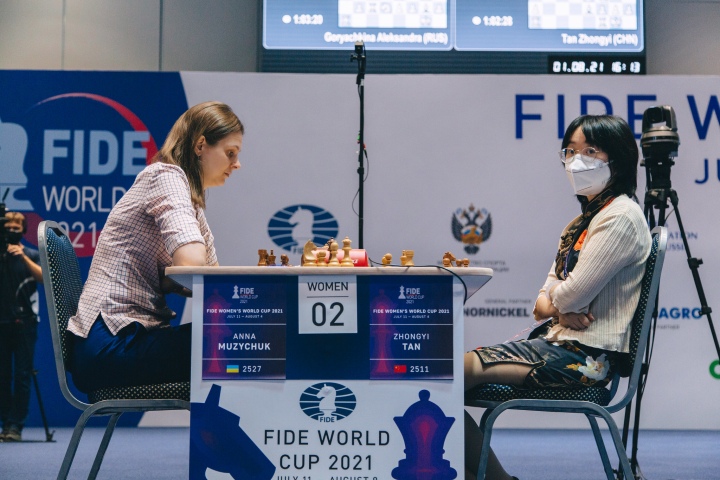
A good result for Muzychuk, who will now enjoy the white pieces in the second game tomorrow.
Pairings of the rounds, live games and PGN files can be found on the World Cup website alongside a great amount of other interesting information such as daily videos, a complete photo collection and other useful data.
Text: Michael Rahal, FIDE Press Officer press@fide.com
Photo: Eric Rosen and Anastasiia Korolkova
About the tournament:
Scheduled to take place from July 12th (Round 1) to August 6th (finals), the 2021 FIDE World Cup will gather together in Sochi (Russia) 309 of the world’s best chess players, with 206 of them playing in the Open World Cup (and 103 participants in the first-ever Women’s World Cup.
The top two finishers in the tournament, aside from World Champion Magnus Carlsen who is also participating, will qualify for the 2022 Candidates Tournament, in addition to winning the 110.000 USD first prize (80.000 USD for the runner-up).
Organisers: International Chess Federation (FIDE), Chess Federation of Russia, Russian Ministry of Sports, and Government of Krasnodar Krai.
Partners:
Gazprom – general partner
Nornickel – general partner
PhosAgro – general partner
Chessable – event’s partner
Aeroflot – CFR’s partner


